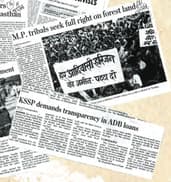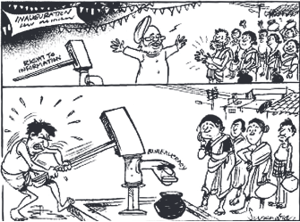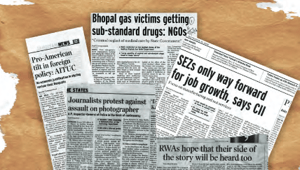Pressure Groups and Movements
Pressure Groups and Movements: Overview
This topic talks about pressure groups which are organisations that attempt to influence government policies. They seek to promote the interest of a particular section. These groups are not healthy because democracy is for all, not one group.
Important Questions on Pressure Groups and Movements
Match the following:
| (a) Organisations that seek to promote the interests of a particular section or group. | (p) Movement |
| (b) Organisations that seek to promote a common interest. | (q) Political parties |
| (c) Struggles launched for the resolution of a social problem with or without an organisational structure. | (r) Sectional interest groups |
| (d) Organisations that mobilise people with the view to win political power. | (s) Public interest groups |
| p | q | r | s | |
| a. | C | D | B | A |
| b. | C | D | A | B |
| c. | D | C | B | A |
| d. | B | C | D | A |
Consider the following statements about pressure groups and parties.
(A) Pressure groups are organised expressions of the interests and views of specific social sections.
(B) Pressure groups take positions on political issues.
(C) All pressure groups are political parties.
Which of the statements given above are correct?
Which among the following is the special feature that distinguishes a pressure group from a political party?
Organisations that undertake activities to promote the interests of specific social sections such as workers, employees, teachers, and lawyers are called _____ (sectional interest/social interest) groups.
"In the s and s, as I was encouraging farmers to plant trees on their land, I also discovered that corrupt government agents were responsible for much of the deforestation by illegally selling off land and trees to well-connected developers. In the early s, the livelihoods, rights, and even the lives of many Kenyans in the Rift Valley were lost when elements of President Daniel Arap Moi's government encouraged ethnic communities to attack one another over land. Supporters of the ruling party got the land, while those in the pro-democracy movement were displaced. It was one of the government's ways of retaining power; If communities were kept busy fighting over land, they would have less opportunity to demand democracy".
In the above passage, what relationship do you see between democracy and social movements? How should this movement respond to the government?What are the social movements listed in these news clippings? What efforts are they making? Which sections are they trying to mobilise?
Do you think the cartoon exaggerates the obstructionist role of bureaucracy in the implementation of the Act?
Can you identify the pressure groups functioning in the news clippings given here? What demand are they making?
What is the difference between a pressure group and a political party?
What is a pressure group? Give a few examples.
Explain how the activities of pressure groups are useful in the functioning of a democratic government.
Describe the forms of relationship between pressure groups and political parties.
In what ways do pressure groups and movements exert influence on politics?



